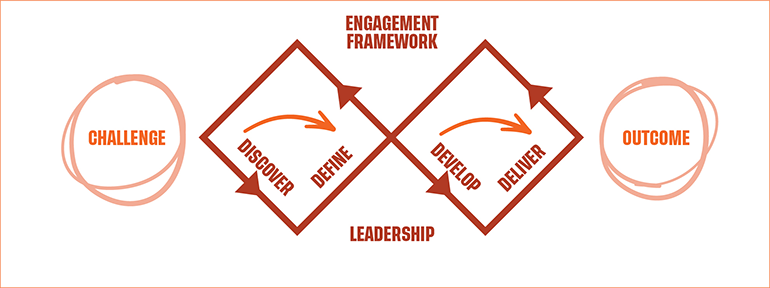Partners and stakeholders
On this page
Reflective of the emphasis on regional relationships, the Group explored many avenues to include voices from across the Bay in this workforce plan.
Since coming together in September 2021, the Group organised and facilitated a series of workshops, issued surveys, and had numerous hui, kōrero and email correspondence with regional iwi and hapū, industry associations, Economic Development Agencies, local employers, education providers, youth training organisations and local and central government agencies.
The plan development and engagement activity followed the methodology of the ‘Double Diamond’ model.[58] The Group followed the principles of co-design where possible, and structured multiple opportunities to seek both stakeholder input and verification through the aspiration and action development phases.

An illustration of the double diamond approach to designing solutions to problems. The diagram starts with a challenge and ends with an outcome. In between are two linked diamond shapes that represent a process of exploring the challenge and landing on the right actions. The first diamond is labelled discover and define. This involves working with people affected by the challenge to better understand and clarify it. The second diamond is labelled develop and deliver. This phase involves developing, testing and refining potential responses to confirm the best choices.
Framework for Innovation: Design Council's evolved Double Diamond(external link) — Design Council
Engagement timeline
Oct-Nov 2021 – Draft aspirations
The RSLG drafted regional workforce aspirations as a group based on its collective knowledge and experience and then developed a stakeholder engagement strategy based on the double framework.
Dec-Jan 2022 – Survey & online communication
The first outward step along the journey was to share draft aspirations with stakeholders via the Group’s member networks and through a regionwide survey.
Feb 2022 – Aspiration workshop
Following our survey the Group facilitated a Zoom workshop designed to test our draft aspirations with stakeholders and gather initial feedback on some actions to sit alongside the aspirations (65 attendees).
Mar 2022 – Actions workshop
A second online workshop to showcase draft actions to regional stakeholders. Designed to further carry forward the kōrero around actions, road-mapping of actions and identification of partners to help implement actions (45 attendees).
Apr 2022 – Reporting back
The Group finished by sharing with all our stakeholders the revised aspirations and actions that had flowed out of all the workshops, survey feedback and conversations, and seeking final comment.
The Group actively sought to kōrero with Te Kahui Mātauranga at regular intervals through the plan development. These hui, facilitated by RSLG Co-Chair Turi Ngatai, allowed the Group an opportunity to socialise this mahi with a range of local iwi leaders throughout the Bay. Due to the pressures, constraints and challenges of the pandemic, the Group were not able to engage as richly as they had planned and hoped to do. The priority focus for the Group is to develop a formalised partnership approach with key stakeholders, such as Te Kāhui Mātauranga, to enable the Group to develop the Tangata o Aotearoa programme of work.
The RSLG also connected with a wide range of established pan-regional groups, including the Waiariki BOP Regional Leadership Group (with iwi, central and local government and New Zealand Police representation) and Connect BOP (a network of central and local government agencies focused on economic development). The Group undertook a range of place-based, sub-regional engagement with groups such as the Eastern Bay of Plenty Workforce Action Network, Taupō Workforce Support Network and the Bay of Plenty Workforce Support Network.
The Group also acknowledges the six Workforce Development Councils/Ohu Mahi (WDC) which were established in October 2021 as part of the Reform of Vocational Education (RoVE).
Collaboration between RSLGs and WDCs is critical for enabling regional views and workforce needs to be reflected and considered in national standards and advice, as well as for facilitating partnership opportunities to support regional initiatives and actions alongside providers and other partners. has strong connections with many of the WDCs as well as having members serving on some WDCs.
The Group intentionally went wide in its outreach to ensure that views and ideas from all sub-regions and sectors in the Bay of Plenty were included as part of the plan development, with documented engagement with over one hundred stakeholders, including:
- Iwi/hapū
- Māori businesses
- Māori regional leadership groups
- Industry associations/Peak Bodies
- Local Councils and EDAs
- Central Government agencies
- Unions
- Sector groups (Kiwifruit, Aquaculture, Agriculture, Tourism)
- Business representatives (Technology, Forestry, Horticulture, Agriculture, Aquaculture, Tourism, Manufacturing, Professional Services)
- Social services providers
- Climate change scientists
- Youth development/support organisations
- Schools and education providers
Where possible, the Group has reflected the views and ideas shared from stakeholders and has noted areas where more thinking and analysis is required to progress. As such, the Group acknowledges that not all stakeholders may see their feedback directly reflected in this first plan. These outstanding matters will be considered and reflected in future iterations of the Regional Workforce Plan.
Footnotes
[58] | Framework for Innovation: Design Council's evolved Double Diamond(external link) — Design Council

